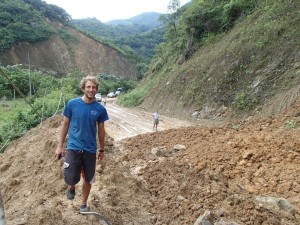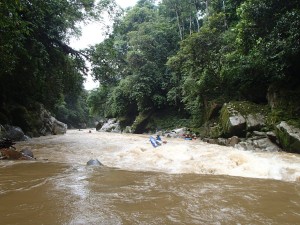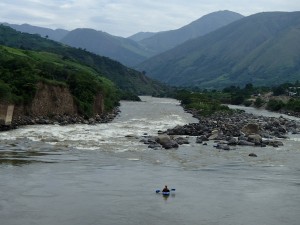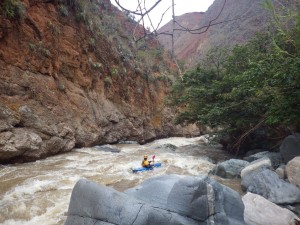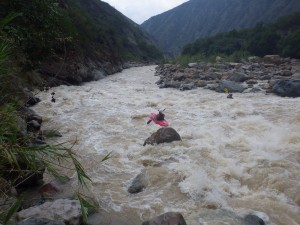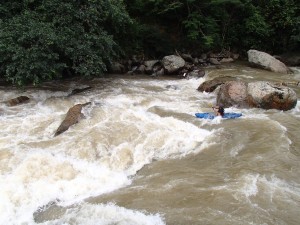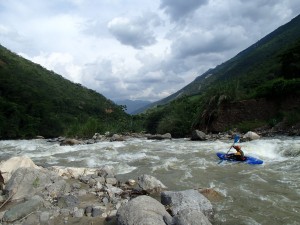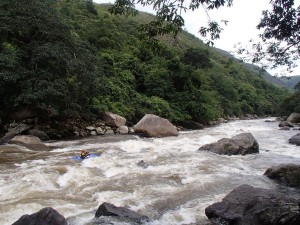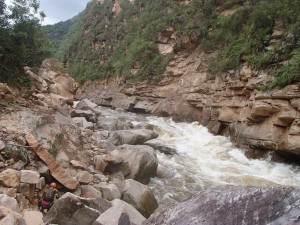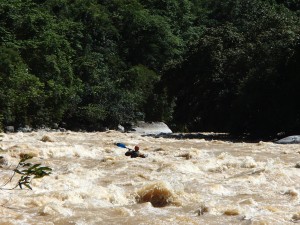Think you know South American paddling? Maybe you’ve been to Chile? Ecuador? Well, the Andes offer much more. A new playground is opening up: northern Peru. It’s got big clean water, multi-days, and lots of creeks.
James “Rocky” Contos of SierraRios has done more in the past couple years to open up Peru to paddlers than anyone since perhaps the Canoandes expedition of 1979. Besides discovering the true source of the Amazon (see below**) he has been running commercial trips, two to four weeks long, on the Amazon’s biggest tributary, the Río Marañon. This is an amazing Grand-Canyon style trip. The Río Marañon cuts a course north almost all the way to the Ecuador border before curving east to feed the Amazon basin.
In early February, a group was finishing off a Marañon trip and Rocky invited some of the better kayakers to join him in exploring some of the bigger tributaries of the Marañon, and Kurt Casey of Peruwhitewater.com and myself hopped onboard. There were nine of us (see below for the names*) who met in Bagua which was our just-outside-the-jungle base for the first river we wanted to explore, the Río Chinchipe. Some parts of this big river (> 10,000 cfs at the confluence) have been run, but as far as we knew no one had attempted it from as high as Rocky had planned…from inside Ecuador! We drove to the border the first day and negotiated our return passport stamps with the officials before venturing into Ecuador the next day. Here the roads became dirt but were passable by our minivan until mid-afternoon until we were blocked by a landslide just outside Palanda. There was nothing to do but leave the boats with a farmer, hoof it to Palanda, and hope the road would open overnight and we could retrieve our boats in the morning. Which did in fact happen. There were several large tributaries to choose from as starting points (future explorers take note) but we opted for what seemed a likely first descent on the Chinchipe’s main tributary, the Río Numbala, putting in at an elevation of 940 m, below a > 100 ft/mi section (next time), about 8 km from Palanda. Rocky estimated a four-day trip, which panned out.
The Numbala was already running > 2000 cfs at that point with busy rapids full of waves and holes. Our goal that day was to meet our raft coming down on the Río Canchis border run, which seemed pretty doubtful considering the 48 km distance, but the jungly solid class IV river turned out to be all read-n-run and despite some flips in the holes there was nothing much to slow us down and we found the rafters at camp shortly below the confluence. We were all beaming from an exciting run and looking forward to more. The next three days the rapids were more spaced out but there was plenty of excitement. The big feature on the second day was the IV+ Naranja rapid, a fearsome stairstep rapid near the road. Rocky rowed the raft, and we all had clean runs, on chicken lines or otherwise. On the morning of the third day we scouting another big rapid which turned out to be pretty clean and offered a fun surf wave at the bottom. By the fourth day things had calmed down quite a bit and we made to the Marañon and the last big wave train rapid shortly after mid-day. Camps were plentiful, pretty, and largely bug-free which was a bonus.
After helping Rocky ship back the expedition gear to Huaraz, and bidding goodbye to our rafter Ira, local guide Luciano, and kakayers Jesse and Scott, the next mission was the Huancabamba, higher up and a bit to the west. This was to be kayak self-support, again four days, so we dropped off our luggage at Jaen (nearby and civilized and our base for the rest of our stay), and drove eight hours into the night and up the mountain to the town. The Huancabamba area was more arid, though it drizzled on us the first day. This was another enjoyable trip with varied desert-like scenery and changing landscape colors. Flow started at a measly 200 cfs but finished well over 2000 cfs. The difficulty was mostly class III with the exception of fun class IV creeky canyon sections the first and second day, and some big water class IVs the last days. The third day we had to paddle across a reservoir created by a dam (diverting water to the Pacific side through a tunnel!) but even that turned into a nice experience as the dam workers helped us portage our stuff to the outlet and even gave us lunch. In general we found the Peruvians very curious about our adventures and proud of their natural resources.
On the fourth day the consummate explorer Rocky paddled the Huancbamba all the way to the hot springs at the Marañon while the rest of us opted to take-out near Jaen. After the Huancabamba it was Kurt and Lorenzo’s turns to head back home, which left Rocky, Josh, and I to continue playing. Our next missions were on rivers that we found while driving or running the first two, all of which turned out to be stellar and turned the difficulty up a notch. First was the Río Chunchuca, 30 km long starting at Chunchuquillo, running at over 2500 cfs with some short sections tilted to 100 ft/mi. The road up is along the river, which was wall-to-wall waves and holes, but it was these steeper sections that gave us some pause. After an hour we got to the first long steep rapid which precipitated some bouldery and brushy portaging. To save time we portaged the next steep parts wholesale, climbing up to some fields and cutting across. We probably portaged a full kilometer all together. On most of the river we moved fast however, and the stormy sea rapids were a hoot. Josh and Rocky christened it the NF Payette of Peru.
At this point Josh had to depart so it was left to just Rocky and me to tackle what turned out to the be the toughest river of the trip: the Chirinos. This big clean river comes into the Chinchipe river-left, which meant a car ferry at Puerto Ciruelo (soon to have a bridge) and then 3 more hours of dirt road. The view of the downstream V-shaped canyon was daunting, especially with 4500 cfs of tea-colored water flowing by with an average gradient of 60 ft/mi, but we put on at 1pm anyway. Just as we congratulated ourselves at passing one rapid, another steeper and longer one would appear. We started running the chicken lines along the shore. We made good progress until about 4:00pm when a class V sequence appeared with a cliff on the left and a fresh rockslide on the right. After some scouting we portaged the beast. Soon after we encountered another steep class V rapid with another grunt of a portage. Things started to ease up a bit but we were still going slow down some chicken lines, then over easier II/III at dusk. Eventually darkness took over and we bivouaced in small caves (I displaced a scorpion in mine) for the night. The next morning it was one big but boat scoutable rapid and then straightforward down to the confluence. We were just 1 km away the night before.
The road back to Jaen passed by another interesting river that was also running full, the Tabaconas, so we decided to make the best of the situation and hopped on that. The Tabaconas was another with good road scouting and turned out to be one big bouncy toboggan ride for about 20 km before getting flatter for the last few kms. Great fun, and raftable, though it would take a little skill to stay out of the trees.
All in all I just can’t say enough about the river running potential in this almost unknown part of Peru. We checked out a couple smaller creeks also that didn’t have enough water, but there are plenty more in the area to explore. Come check it out, maybe in conjunction with a raft-supported Marañon trip, or on your own. SierraRios has gear for rent which is helpful the way airlines are these days.
Some of these rivers are already written up on peruwhitewater.com, another good resource for Peru beta.
* Paddlers participating included Kurt Casey, Josh Fischer, Scott McBride, Lorenzo Bergamin, Jesse Mogler, Rocky Contos, Greg Schwendinger, rafter Ira Estin, and local guide Luciano Troyes from Jaen who runs the nearby Gotas de Agua nature reserve.
** Here are some links to news/scientific articles covering Rocky’s Amazon source discoveries:
http://news.nationalgeographic.com/news/2014/02/140213-amazon-river-length-source-maps-science/
http://www.foxnews.com/science/2014/02/14/scientists-weve-found-amazon-river-true-source/?intcmp=features
http://www.larepublica.pe/08-03-2014/la-naciente-del-amazonas-esta-en-el-rio-mantaro
(and the scientific article itself) https://www.dropbox.com/s/q25modceshibnsw/AREA_ContosTripcevich.pdf
